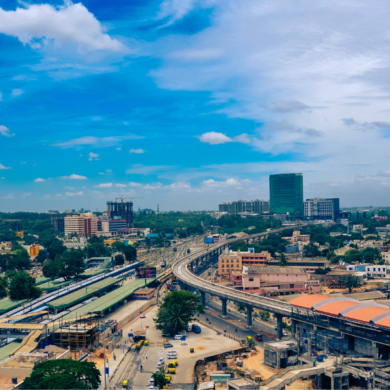Impact of Infrastructure Development on Chennai Real Estate Market
May 9th, 2025

Infrastructure is the backbone of real estate growth. Every new flyover, metro line, or IT corridor in the city is not just a development; it is also a catalyst for Chennai real estate market – as it redefines property demand, pricing, and lifestyle aspirations.
Fuelled by strategic infrastructure developments, economic growth, and improved connectivity, Chennai real estate market is evolving rapidly. From Chennai Metro expansion to upgraded civic facilities and the emergence of industrial corridors, the city is transforming into a magnet for both residential and commercial investments.
Well-established IT zones along OMR and ECR – alongside sought-after areas such as Porur, Kelambakkam, Tambaram, and Velachery – are witnessing high demand. Urban growth has resulted in rising land values and steady appreciation in Chennai property prices, particularly in well-connected and developing locales. Strengthened by the influx of professionals and families, the robust rental market further adds to investor confidence.
Government initiatives such as streamlined approvals, improved infrastructure policy, and Smart City projects are reshaping urban planning and liveability. Whether you are a homebuyer, NRI, HNI, or commercial investor, the city presents a stable and future-ready landscape for real estate opportunities.
Table of Contents
Infrastructure Development in Chennai
Tamil Nadu’s capital is undergoing significant enhancements, including the ₹63,246 crore Chennai Metro Phase II expansion, proposed Chennai Greenfield Airport at Parandur, and the ₹1660 crore urban upgrade featuring road improvements and modernised bus terminals. Also, Chennai-Bangalore Expressway NE7 and TIDEL Park in Pattabiram are expected to boost connectivity and economic growth.
-
Transport & Connectivity in Chennai
The city is undergoing significant infrastructure enhancements to improve transport and connectivity. Spanning 118.9 km with 128 stations across 3 corridors, Chennai Metro Rail Phase 2 aims for phased completion by 2030. Chennai-Bangalore Industrial Corridor is set to enhance regional connectivity and economic growth, with expected completion by 2025.
The 62 km Outer Ring Road and the 132.87 km Peripheral Ring Road that are under development, will alleviate traffic congestion and connect key industrial hubs. Upgrades in suburban rail include the introduction of air-conditioned EMU services, while MTC (Metropolitan Transport Corporation) is implementing digital ticketing systems to enhance commuter experience.
-
Smart City Initiatives & Urban Planning
Chennai’s Smart City Mission is advancing in areas like T. Nagar, Perungudi, and Guindy – introducing smart mobility, flood management, and e-governance solutions. The IT corridor is expanding with OMR-ECR link road, aiming to ease congestion and enhance connectivity.
GST Road developments are attracting major corporations, while redevelopment projects such as Central Square and Egmore station are revitalising commercial hubs and improving urban infrastructure.
-
Industrial & Economic Growth in Chennai
Anchored by major IT parks such as TIDEL Park, DLF Cyber City, and SIPCOT IT Park – that collectively enhance the city’s technology sector – the city’s industrial and economic landscape is thriving. The automobile and manufacturing industries are robust, with Chennai producing 30% of India’s vehicles and 35% of auto components – earning it the moniker ‘Detroit of Asia’.
India’s second largest container port, Chennai Port is undergoing significant expansion – complemented by the development of logistics hubs like Rajiv Gandhi dry port near Sriperumbudur, to bolster trade and connectivity.
-
Social & Civic Infrastructure
Chennai is enhancing its social and civic infrastructure through various initiatives. New educational institutions, including expansions in Porur and Vadapalani, are providing residents with access to quality education. Healthcare facilities are also improving, with developments such as MGM Healthcare offering advanced medical services.
The city is witnessing growth in shopping malls and entertainment zones, with establishments like Nexus Vijaya Mall Vadapalani and Phoenix Marketcity Velachery offering diverse retail and leisure options. Entertainment hubs such as Kathipara Urban Square are enhancing the city’s recreational landscape.
Efforts to improve water supply and drainage systems are underway, including the inauguration of a water treatment plant supplying 26.58 million litres per day to areas like Ramapuram. Additionally, projects like City of 1000 Tanks aim to address flooding and water scarcity issues across Chennai.
How Infrastructure Development in Chennai Impacts its Real Estate Market
Driven by new infrastructure development in Chennai and extensive upgrades, property market is experiencing notable growth. The expansion of Chennai Metro Rail, enhancement of road networks, and Smart City initiatives have significantly improved connectivity and urban living standards.
Planned advancements have led to increased demand for residential and commercial properties, resulting in 5-7% rise in Chennai property prices. Emerging areas and well-connected corridors are attracting investors and homebuyers seeking long-term value.
-
Rising Property Rates
In locales such as Anna Nagar, Velachery, and Porur, rates are witnessing a steady rise. Metro expansion and infrastructure development have increased accessibility, driving homebuyer demand. Land values in developing areas such as Perungalathur and Kelambakkam are surging, as investors target long-term capital appreciation. With rapid urbanisation, families and investors are showing greater interest in plots and apartments – leading to an overall upward trend in Chennai property prices.
-
Emerging Real Estate Hotspots
Real estate investment in Chennai is witnessing significant growth in hotspots such as OMR, ECR, Porur, Perungalathur, and Tambaram. OMR and ECR attract IT professionals and investors, due to robust infrastructure and proximity to tech hubs. Porur is evolving into a prominent IT and residential zone, offering excellent connectivity and social infrastructure.
Perungalathur and Tambaram are gaining traction for their diverse rates and improved transport links. Driven by ongoing infrastructure developments and increasing demand, all these areas present high investment potential.
-
Increased Rental Demand
Expanding employment opportunities in IT, manufacturing, and logistics sectors have led to significant growth in Chennai’s rental market. This surge has led to increased migration, particularly among professionals seeking housing near employment hubs. Consequently, rental yields have risen, with residential properties offering returns around 5% and commercial spaces yielding between 7% and 8%.
Average residential rents grew by 22.2% quarter-on-quarter in Q3 2024, marking the sharpest increase among major Indian cities. This trend underscores Chennai’s growing appeal for rental investments.
-
Boost in Commercial Real Estate
Driven by the expansion of IT, retail, and industrial spaces, Chennai’s commercial real estate sector is experiencing robust growth. The city’s office stock surpassed 89 mn sq ft in Dec 2024, with projections to exceed 100 million sq ft by 2026 – reflecting high demand from global corporations and domestic enterprises.
The rise of coworking spaces is notable, with 241 facilities as of Dec 2024, marking 6.58% year-over-year increase. Additionally, significant investments in logistics and warehousing, such as IndoSpace’s $536 million commitment in Tamil Nadu, underscore the city’s growing appeal as a commercial hub.
Future Outlook & Investment Opportunities in Chennai
Over the next 5-10 years, Chennai real estate market will experience steady growth – due to robust infrastructure development, expanding employment hubs, and supportive government policies. Driven by ongoing projects like Chennai Metro Phase II, Peripheral Ring Road, Chennai-Bangalore Industrial Corridor, and Chennai-Bangalore Expressway NE7, a steady increase in Chennai property prices is expected. These developments will enhance connectivity, attract residential & commercial investments, and create promising opportunities for investors seeking long-term growth and stability.
-
Best Areas for Real Estate Investment in Chennai
Porur stands out as a prime investment destination due to excellent connectivity and strategic location near IT corridors. Located near OMR, Kelambakkam offers diverse housing options and proximity to SIPCOT IT Park, making it attractive for both families and investors.
-
Government Policies & Incentives
Tamil Nadu government’s initiatives, such as the Single Window Clearance system, will continue to streamline approval processes and encourage real estate development. Additionally, revised zoning regulations and infrastructure development in Chennai will transform developing areas into investment hotspots.
Also Read: Top Benefits of Buying DTCP-approved Plots in Chennai
Conclusion
With a strong foundation built on infrastructure, industrial expansion, and urban renewal, Chennai’s real estate outlook remains highly promising. Property values continue to appreciate in core locations and upcoming areas, driven by connectivity upgrades like Metro Phase II and highway corridors. Locations such as Porur and Kelambakkam offer strategic advantages in terms of accessibility and ROI.
The commercial segment is equally dynamic – with IT parks, coworking hubs, and logistics infrastructure attracting institutional investments. Rising rental yields, particularly in employment-driven zones, offer passive income potential for residential and commercial investors alike.
Supporting this growth are state-led incentives, streamlined approval processes, and urban development policies that make investing in Chennai increasingly viable. As the city continues to align with global urban standards, real estate here is not just about ownership – it is about securing a future in one of the most progressive metropolitan economies in India. For investors, the next decade in Chennai looks decisively opportunity-rich.
FAQs
1. How does infrastructure development in Chennai impact property prices?
Infrastructure development in Chennai impacts property prices positively – by enhancing connectivity, boosting accessibility, and increasing land value in emerging corridors. Projects like metro expansion and ring roads attract homebuyers and investors, leading to higher demand and steady appreciation in both residential and commercial real estate segments.
2. Which areas in Chennai are benefiting the most from infrastructure growth?
Areas in Chennai benefiting the most from infrastructure growth include OMR, Porur, Tambaram, Perungalathur, and Kelambakkam. These offer improved connectivity through highways and metro lines, proximity to IT parks, and better facilities – making them attractive for real estate investment in Chennai.
3. How does metro rail expansion impact real estate investment in Chennai?
Metro rail expansion impacts real estate investment in Chennai positively – by improving accessibility, reducing travel time, and boosting property values along multiple lines. Areas near upcoming metro stations witness increased buyer interest, rental demand, and investor activity – leading to rapid urbanisation and rising Chennai property prices.
4. What are some major infrastructure projects shaping Chennai real estate market?
Major infrastructure projects shaping Chennai real estate market are Metro Rail Phase II, Chennai Peripheral Ring Road, Outer Ring Road upgrades, Chennai-Bangalore Industrial Corridor, and Chennai-Bangalore Expressway NE7. These developments improve connectivity, drive migration, and attract residential & commercial investments in key areas across the city.
5. Is real estate investment in Chennai a good proposition in 2024?
Yes, real estate investment in Chennai is a good proposition in 2024 – as robust infrastructure, industrial growth, metro expansion, and increasing demand in areas like OMR, Porur, and Tambaram ensure long-term value appreciation, stable rental income, and future-ready market for both residential and commercial investors.
6. How does infrastructure development in Chennai impact rental yields?
Infrastructure development in Chennai impacts rental yields positively, by improving liveability and drawing professionals closer to employment hubs. Better connectivity through roads and metro lines increases rental demand in developing areas, enabling investors to receive higher rents and secure consistent returns on residential and commercial properties.
7. How does industrial and economic growth impact Chennai real estate market?
Industrial and economic growth impact Chennai real estate market positively – by creating jobs, encouraging property purchase, and increasing housing demand. Expansion of SEZs, IT parks, and manufacturing zones boosts residential and commercial property development – leading to rising Chennai property prices, rental yields, and investor confidence across key corridors.
8. Which localities in Chennai are expected to see the highest property appreciation?
Localities in Chennai expected to see the highest property appreciation are Porur, Kelambakkam, Perungalathur, and Tambaram – as they benefit from proximity to key employment zones, metro expansion, and improved civic infrastructure – making them hotspots for long-term capital growth and strategic residential or rental investments.
9. Are there any government initiatives boosting real estate in Chennai?
Yes, there are government initiatives boosting real estate in Chennai – such as Smart City Mission, Single Window Clearance system, and infrastructure push through metro, ring roads, and industrial corridors. These reforms simplify approvals, improve urban planning, and promote faster development across residential & commercial zones.
10. What should investors consider before buying property in Chennai?
Before buying property in Chennai, investors should consider connectivity, infrastructure growth, proximity to employment hubs, RERA registration, price trends, high-growth areas such as OMR or Porur, legal clearances, long-term investment goals, and risk-return ratio.







